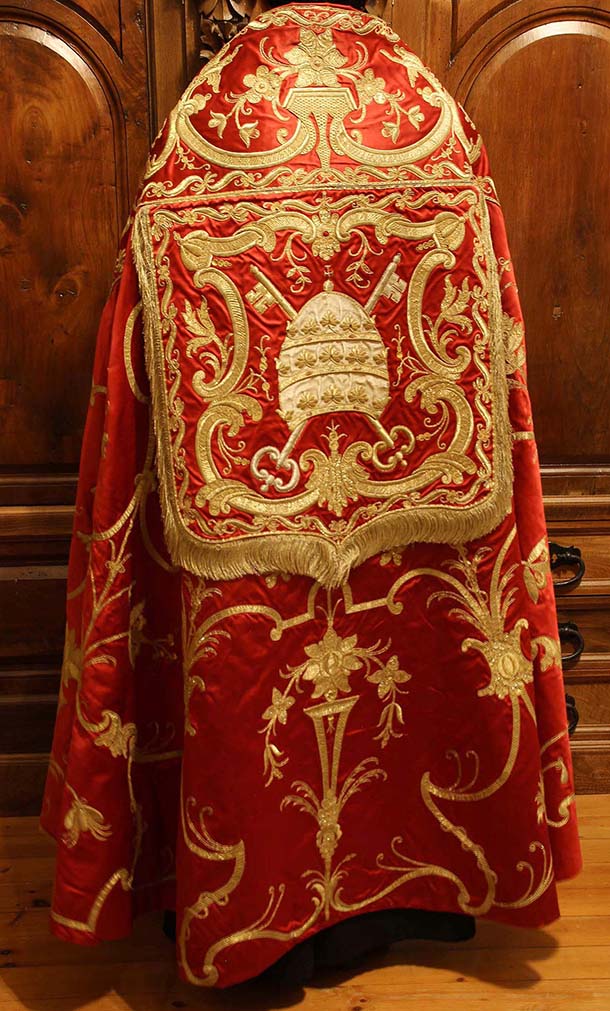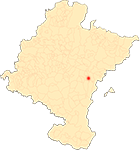Parish Church of San Pedro de Aibar
Crimson suit
The parish of Aibar has magnificent pieces of ornamentation that contributed to give greater magnificence to divine worship. As in the field of goldsmithing, this temple also provided its sacristy with rich ornaments that dignified the sacred ceremonies. In this sense, the drawers of Aibar house a lavish crimson and gold robe destined for the greatest solemnities of the parish, among them that of its titular, the martyr and apostle St. Peter. The terno, as its own name announces, is a set of vestments composed of three main pieces destined to clothe the priest, the deacon and the subdeacon in some sacred functions, mainly the mass. Therefore, it is composed of a chasuble and pluvial cloak for the priest and two dalmatics for the deacon and the subdeacon.
The richness and exuberance of the pieces are in keeping with their provenance. According to sample the specialist Alicia Andueza in her thesis , the terno was commissioned by the parish in the city of Zaragoza to the embroiderer Joaquín Lázaro in 1797. Not in vain, Zaragoza was one of the most powerful centers in the art of embroidery during the centuries of the Baroque, with many of the sacristies of Navarre housing ternos from workshops in the Aragonese capital. In this case, the vestment is embroidered in gold on crimson satin. The chasuble on one of its sides sample a monstrance among a decoration of rocailles and vegetal motifs. On the back of the chasuble is the papal tiara with the keys, the main attributes of the patron saint of the church of Aibar. The same motif is present on the pluvial cape in its hood.
ARAGONÉS, E., "El románico de Sangüesa", El Arte en Navarra, volume 1, Pamplona, Diario de Navarra, 1994, pp. 65-80.
FERNÁNDEZ GRACIA, R., ANDUEZA UNANUA, P., AZANZA LÓPEZ, J. and GARCÍA GAINZA, M.C., El arte del Barroco en Navarra, Pamplona, Gobierno de Navarra, 2014.
FERNÁNDEZ GRACIA, R., ECHEVERRÍA GOÑI, P.L. and GARCÍA GAINZA, M.C., El arte del renacimiento en Navarra, Pamplona, Gobierno de Navarra, 2005.
FERNÁNDEZ-LADREDA, C., MARTÍNEZ DE AGUIRRE, J. and MARTÍNEZ ÁLAVA, C.J., El arte románico en Navarra, Pamplona, Gobierno de Navarra, 2004.
FERNÁNDEZ-LADREDA, C., MARTÍNEZ ÁLAVA, C.J., MARTÍNEZ DE AGUIRRE, J. and LACARRA DUCAY, M.C., El Arte Gótico en Navarra, Pamplona, Gobierno de Navarra, 2015.
GARCÍA GAINZA, M.C. and ORVE SIVATTE, M., Catalog Monumental de Navarra. Merindad de Sangüesa, volume IV*, Pamplona, Government of Navarra, 1989.
GARCÍA GAINZA, M.C., La Escultura Romanista en Navarra, Pamplona, Government of Navarre, 1986.
HEREDIA MORENO, M.C., ORVE SIVATTE, M. and ORVE SIVATTE, A., Arte hispanoamericano en Navarra. Silver, painting and sculpture. Pamplona, Government of Navarre, 1992.
IZIZ ELARRE, R., Aibar-Oibar. Historia, volume 1, Tafalla, Altaffaylla Kultur Taldea, 2008.
LARRIÓN, J.L., "Romerías", Temas de Cultura Popular, number 42, Pamplona, Diputación Foral de Navarra, 1969.
LEOJENDIO, L.M., "pathway del Románico", Temas de Cultura Popular, number 85, Pamplona, Diputación Foral de Navarra, 1975.
SAGASETA, A. and TABERNA, L. Órganos de Navarra, Pamplona, Government of Navarre, 1985.












